Strategic Analysis of Sainsbury: SIM336 Strategic Management Report
VerifiedAdded on 2023/01/06
|13
|3738
|91
Report
AI Summary
This report offers a comprehensive analysis of strategic management, focusing on the UK retail giant, Sainsbury. It begins with an introduction to strategic management, emphasizing its importance in business monitoring, assessment, and analysis to meet long-term goals. The main body delves into the identified issues Sainsbury faces, including industry pressures, changing consumer preferences, and the impact of Brexit. The report then explores strategic theories and models, including Porter's Five Forces, SWOT analysis, and the VRIO framework, to evaluate Sainsbury's position within the competitive retail landscape. It further examines strategic management theories such as Porter's generic competitive strategies and corporate portfolio strategy. The report concludes with recommendations for Sainsbury and a summary of its findings, providing valuable insights into strategic planning and implementation within a dynamic business environment.
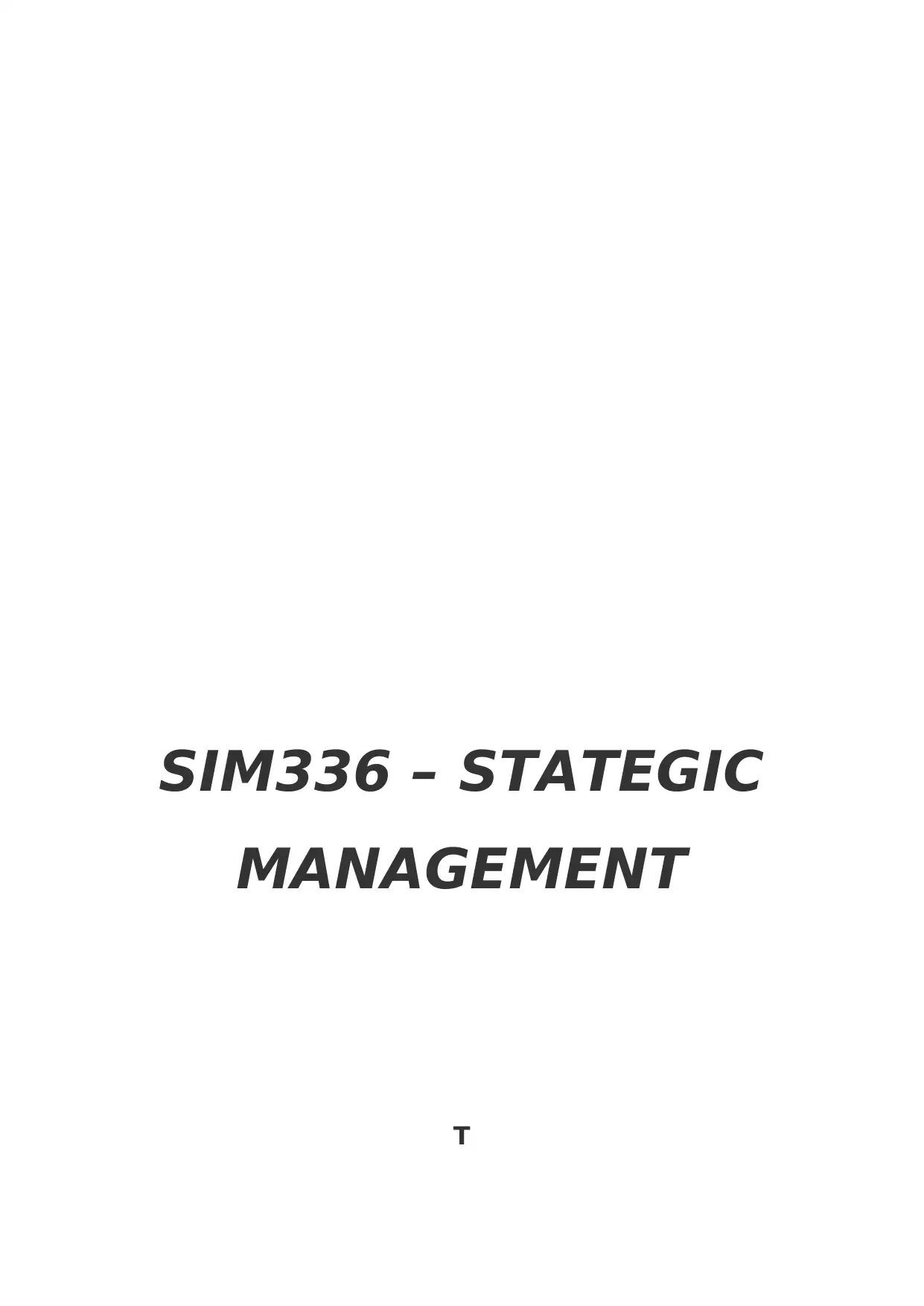
SIM336 – STATEGIC
MANAGEMENT
T
MANAGEMENT
T
Paraphrase This Document
Need a fresh take? Get an instant paraphrase of this document with our AI Paraphraser
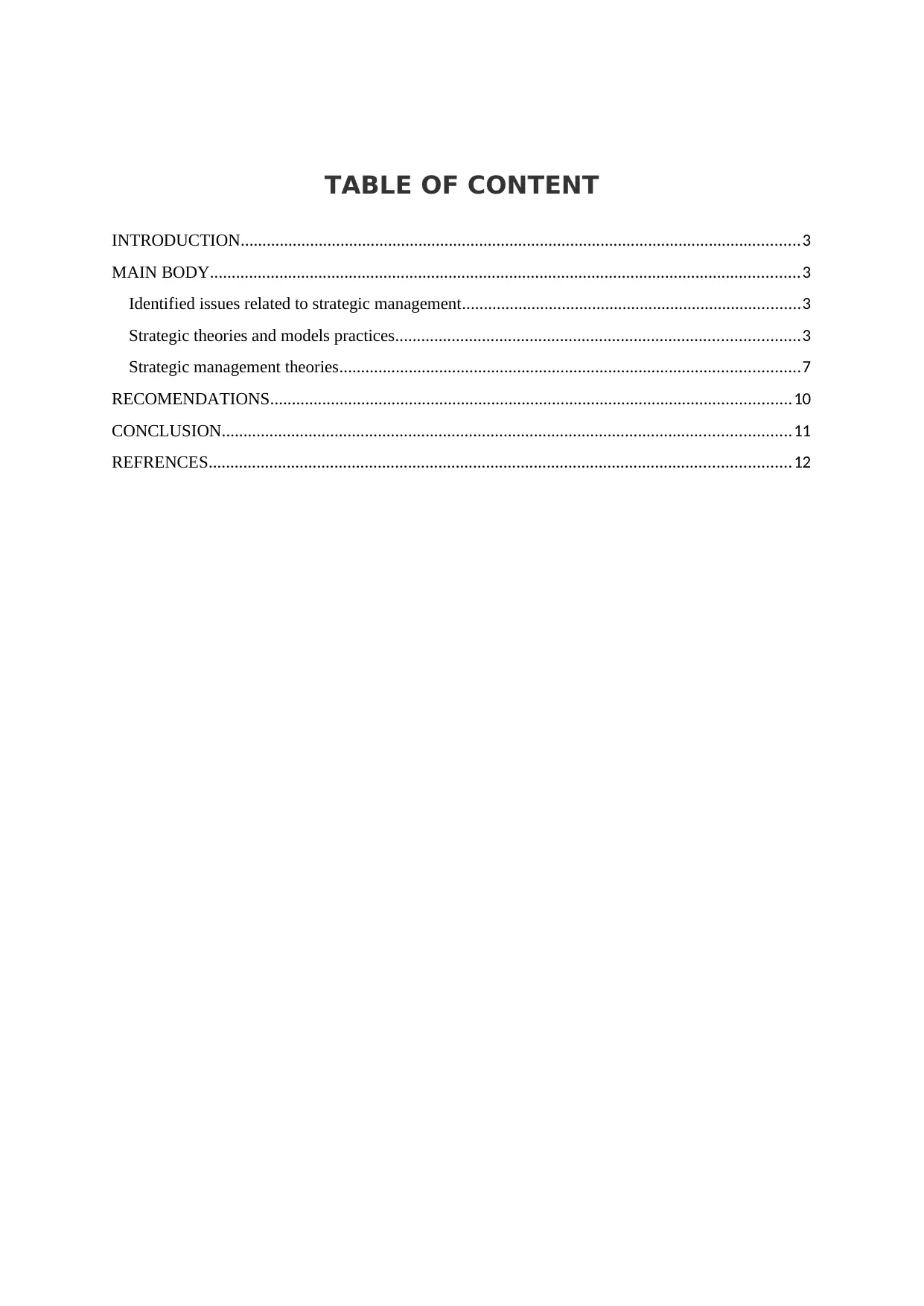
TABLE OF CONTENT
INTRODUCTION.................................................................................................................................3
MAIN BODY........................................................................................................................................3
Identified issues related to strategic management..............................................................................3
Strategic theories and models practices.............................................................................................3
Strategic management theories..........................................................................................................7
RECOMENDATIONS........................................................................................................................10
CONCLUSION...................................................................................................................................11
REFRENCES......................................................................................................................................12
INTRODUCTION.................................................................................................................................3
MAIN BODY........................................................................................................................................3
Identified issues related to strategic management..............................................................................3
Strategic theories and models practices.............................................................................................3
Strategic management theories..........................................................................................................7
RECOMENDATIONS........................................................................................................................10
CONCLUSION...................................................................................................................................11
REFRENCES......................................................................................................................................12
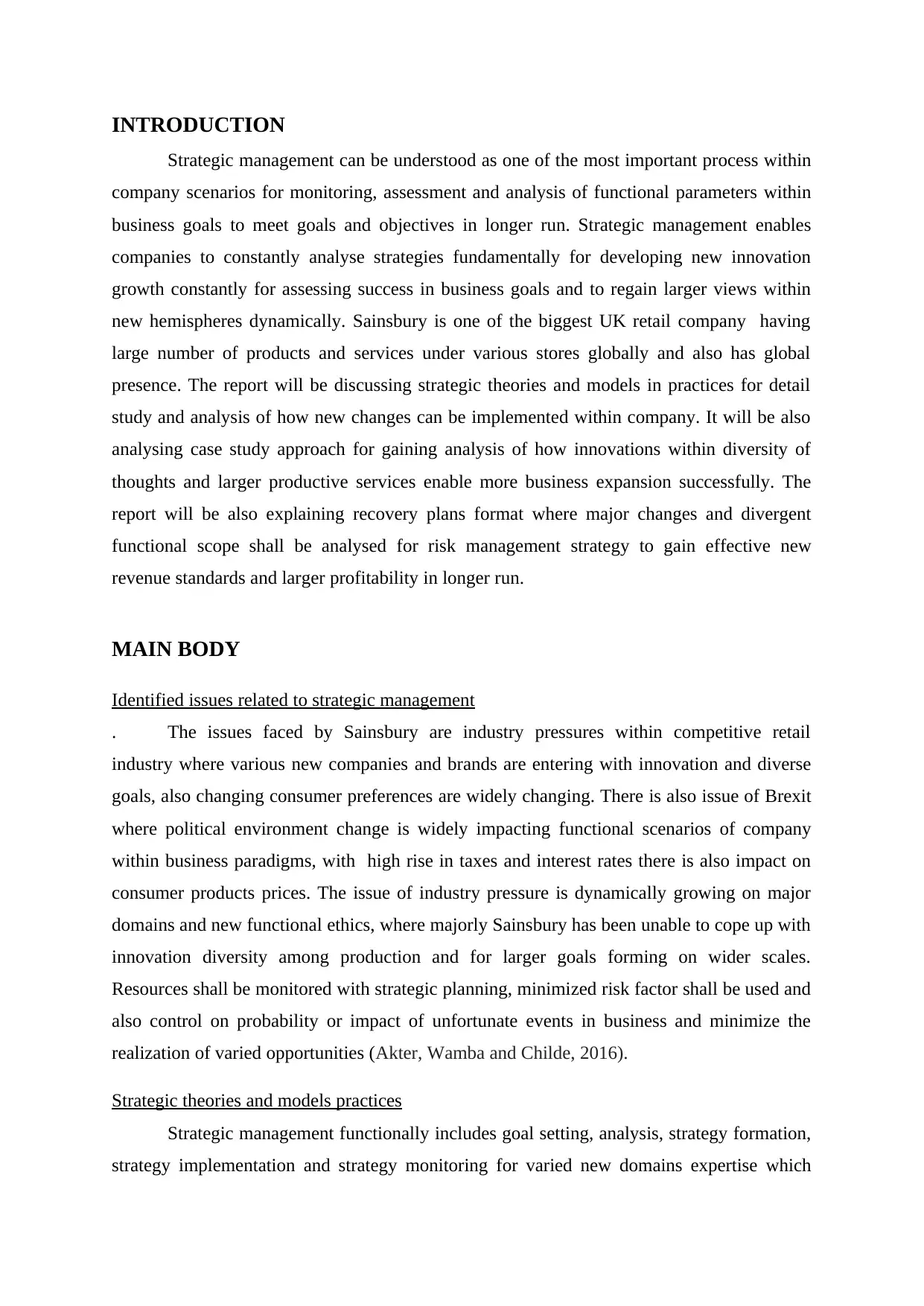
INTRODUCTION
Strategic management can be understood as one of the most important process within
company scenarios for monitoring, assessment and analysis of functional parameters within
business goals to meet goals and objectives in longer run. Strategic management enables
companies to constantly analyse strategies fundamentally for developing new innovation
growth constantly for assessing success in business goals and to regain larger views within
new hemispheres dynamically. Sainsbury is one of the biggest UK retail company having
large number of products and services under various stores globally and also has global
presence. The report will be discussing strategic theories and models in practices for detail
study and analysis of how new changes can be implemented within company. It will be also
analysing case study approach for gaining analysis of how innovations within diversity of
thoughts and larger productive services enable more business expansion successfully. The
report will be also explaining recovery plans format where major changes and divergent
functional scope shall be analysed for risk management strategy to gain effective new
revenue standards and larger profitability in longer run.
MAIN BODY
Identified issues related to strategic management
. The issues faced by Sainsbury are industry pressures within competitive retail
industry where various new companies and brands are entering with innovation and diverse
goals, also changing consumer preferences are widely changing. There is also issue of Brexit
where political environment change is widely impacting functional scenarios of company
within business paradigms, with high rise in taxes and interest rates there is also impact on
consumer products prices. The issue of industry pressure is dynamically growing on major
domains and new functional ethics, where majorly Sainsbury has been unable to cope up with
innovation diversity among production and for larger goals forming on wider scales.
Resources shall be monitored with strategic planning, minimized risk factor shall be used and
also control on probability or impact of unfortunate events in business and minimize the
realization of varied opportunities (Akter, Wamba and Childe, 2016).
Strategic theories and models practices
Strategic management functionally includes goal setting, analysis, strategy formation,
strategy implementation and strategy monitoring for varied new domains expertise which
Strategic management can be understood as one of the most important process within
company scenarios for monitoring, assessment and analysis of functional parameters within
business goals to meet goals and objectives in longer run. Strategic management enables
companies to constantly analyse strategies fundamentally for developing new innovation
growth constantly for assessing success in business goals and to regain larger views within
new hemispheres dynamically. Sainsbury is one of the biggest UK retail company having
large number of products and services under various stores globally and also has global
presence. The report will be discussing strategic theories and models in practices for detail
study and analysis of how new changes can be implemented within company. It will be also
analysing case study approach for gaining analysis of how innovations within diversity of
thoughts and larger productive services enable more business expansion successfully. The
report will be also explaining recovery plans format where major changes and divergent
functional scope shall be analysed for risk management strategy to gain effective new
revenue standards and larger profitability in longer run.
MAIN BODY
Identified issues related to strategic management
. The issues faced by Sainsbury are industry pressures within competitive retail
industry where various new companies and brands are entering with innovation and diverse
goals, also changing consumer preferences are widely changing. There is also issue of Brexit
where political environment change is widely impacting functional scenarios of company
within business paradigms, with high rise in taxes and interest rates there is also impact on
consumer products prices. The issue of industry pressure is dynamically growing on major
domains and new functional ethics, where majorly Sainsbury has been unable to cope up with
innovation diversity among production and for larger goals forming on wider scales.
Resources shall be monitored with strategic planning, minimized risk factor shall be used and
also control on probability or impact of unfortunate events in business and minimize the
realization of varied opportunities (Akter, Wamba and Childe, 2016).
Strategic theories and models practices
Strategic management functionally includes goal setting, analysis, strategy formation,
strategy implementation and strategy monitoring for varied new domains expertise which
⊘ This is a preview!⊘
Do you want full access?
Subscribe today to unlock all pages.

Trusted by 1+ million students worldwide
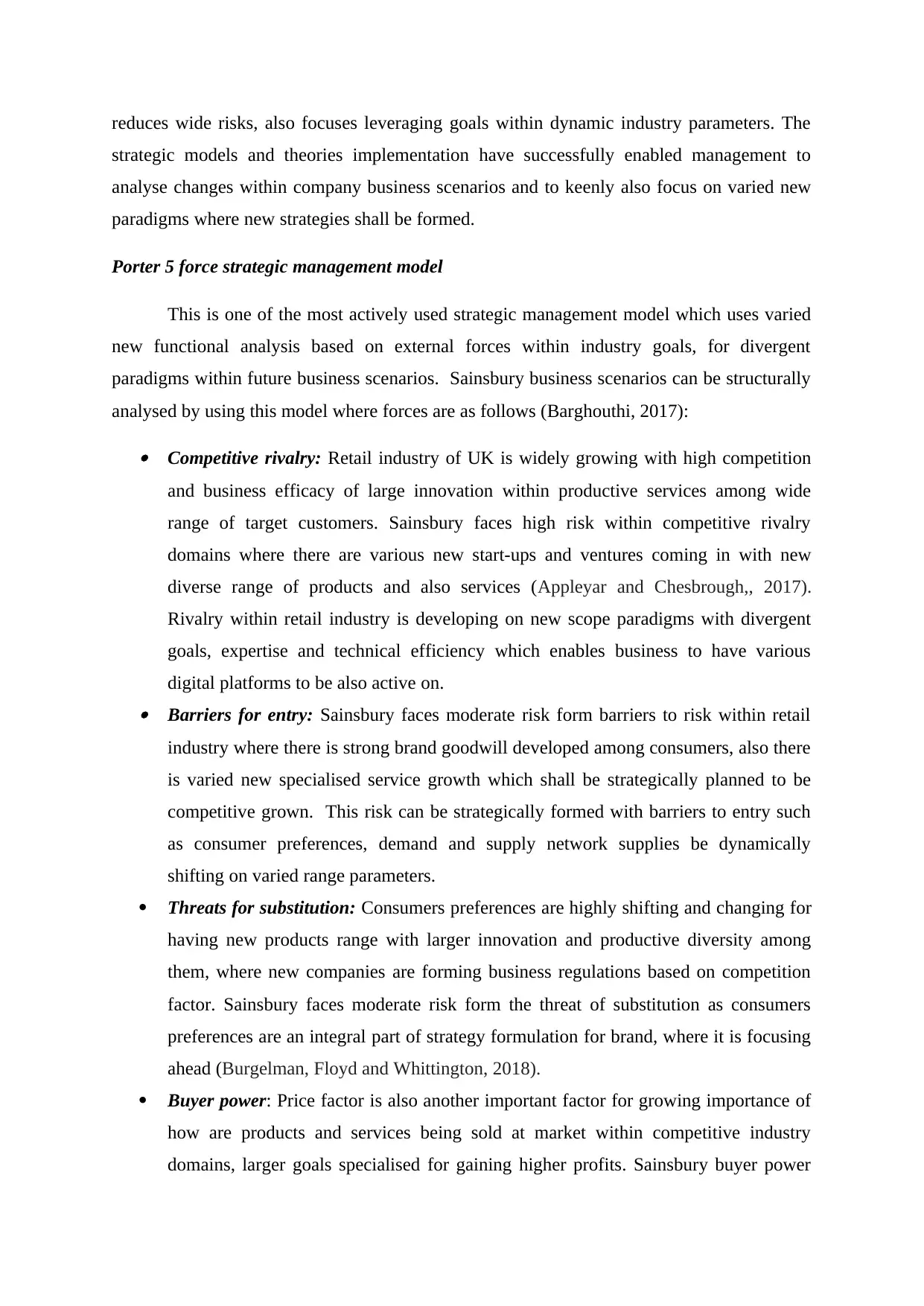
reduces wide risks, also focuses leveraging goals within dynamic industry parameters. The
strategic models and theories implementation have successfully enabled management to
analyse changes within company business scenarios and to keenly also focus on varied new
paradigms where new strategies shall be formed.
Porter 5 force strategic management model
This is one of the most actively used strategic management model which uses varied
new functional analysis based on external forces within industry goals, for divergent
paradigms within future business scenarios. Sainsbury business scenarios can be structurally
analysed by using this model where forces are as follows (Barghouthi, 2017):
Competitive rivalry: Retail industry of UK is widely growing with high competition
and business efficacy of large innovation within productive services among wide
range of target customers. Sainsbury faces high risk within competitive rivalry
domains where there are various new start-ups and ventures coming in with new
diverse range of products and also services (Appleyar and Chesbrough,, 2017).
Rivalry within retail industry is developing on new scope paradigms with divergent
goals, expertise and technical efficiency which enables business to have various
digital platforms to be also active on. Barriers for entry: Sainsbury faces moderate risk form barriers to risk within retail
industry where there is strong brand goodwill developed among consumers, also there
is varied new specialised service growth which shall be strategically planned to be
competitive grown. This risk can be strategically formed with barriers to entry such
as consumer preferences, demand and supply network supplies be dynamically
shifting on varied range parameters.
Threats for substitution: Consumers preferences are highly shifting and changing for
having new products range with larger innovation and productive diversity among
them, where new companies are forming business regulations based on competition
factor. Sainsbury faces moderate risk form the threat of substitution as consumers
preferences are an integral part of strategy formulation for brand, where it is focusing
ahead (Burgelman, Floyd and Whittington, 2018).
Buyer power: Price factor is also another important factor for growing importance of
how are products and services being sold at market within competitive industry
domains, larger goals specialised for gaining higher profits. Sainsbury buyer power
strategic models and theories implementation have successfully enabled management to
analyse changes within company business scenarios and to keenly also focus on varied new
paradigms where new strategies shall be formed.
Porter 5 force strategic management model
This is one of the most actively used strategic management model which uses varied
new functional analysis based on external forces within industry goals, for divergent
paradigms within future business scenarios. Sainsbury business scenarios can be structurally
analysed by using this model where forces are as follows (Barghouthi, 2017):
Competitive rivalry: Retail industry of UK is widely growing with high competition
and business efficacy of large innovation within productive services among wide
range of target customers. Sainsbury faces high risk within competitive rivalry
domains where there are various new start-ups and ventures coming in with new
diverse range of products and also services (Appleyar and Chesbrough,, 2017).
Rivalry within retail industry is developing on new scope paradigms with divergent
goals, expertise and technical efficiency which enables business to have various
digital platforms to be also active on. Barriers for entry: Sainsbury faces moderate risk form barriers to risk within retail
industry where there is strong brand goodwill developed among consumers, also there
is varied new specialised service growth which shall be strategically planned to be
competitive grown. This risk can be strategically formed with barriers to entry such
as consumer preferences, demand and supply network supplies be dynamically
shifting on varied range parameters.
Threats for substitution: Consumers preferences are highly shifting and changing for
having new products range with larger innovation and productive diversity among
them, where new companies are forming business regulations based on competition
factor. Sainsbury faces moderate risk form the threat of substitution as consumers
preferences are an integral part of strategy formulation for brand, where it is focusing
ahead (Burgelman, Floyd and Whittington, 2018).
Buyer power: Price factor is also another important factor for growing importance of
how are products and services being sold at market within competitive industry
domains, larger goals specialised for gaining higher profits. Sainsbury buyer power
Paraphrase This Document
Need a fresh take? Get an instant paraphrase of this document with our AI Paraphraser
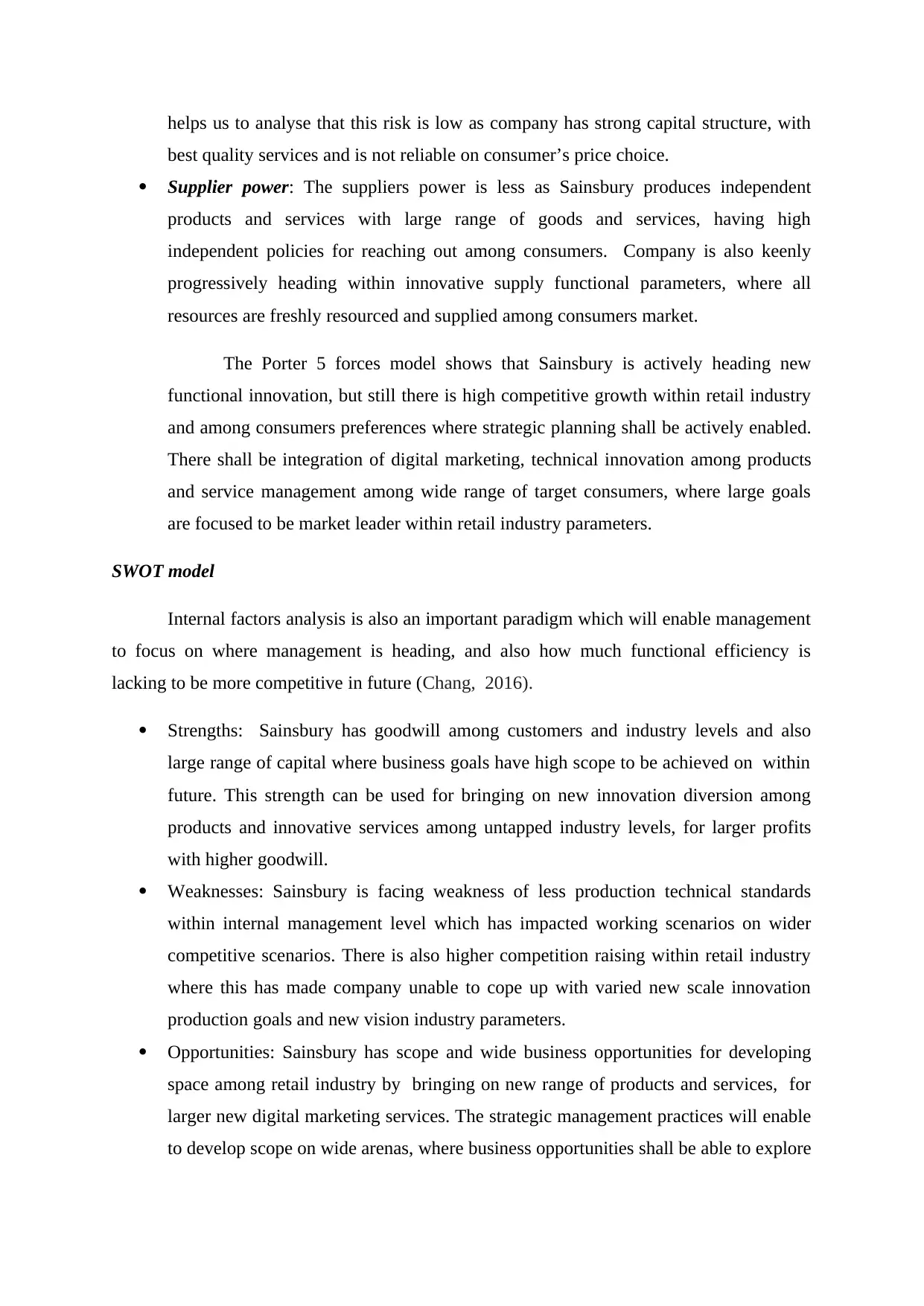
helps us to analyse that this risk is low as company has strong capital structure, with
best quality services and is not reliable on consumer’s price choice.
Supplier power: The suppliers power is less as Sainsbury produces independent
products and services with large range of goods and services, having high
independent policies for reaching out among consumers. Company is also keenly
progressively heading within innovative supply functional parameters, where all
resources are freshly resourced and supplied among consumers market.
The Porter 5 forces model shows that Sainsbury is actively heading new
functional innovation, but still there is high competitive growth within retail industry
and among consumers preferences where strategic planning shall be actively enabled.
There shall be integration of digital marketing, technical innovation among products
and service management among wide range of target consumers, where large goals
are focused to be market leader within retail industry parameters.
SWOT model
Internal factors analysis is also an important paradigm which will enable management
to focus on where management is heading, and also how much functional efficiency is
lacking to be more competitive in future (Chang, 2016).
Strengths: Sainsbury has goodwill among customers and industry levels and also
large range of capital where business goals have high scope to be achieved on within
future. This strength can be used for bringing on new innovation diversion among
products and innovative services among untapped industry levels, for larger profits
with higher goodwill.
Weaknesses: Sainsbury is facing weakness of less production technical standards
within internal management level which has impacted working scenarios on wider
competitive scenarios. There is also higher competition raising within retail industry
where this has made company unable to cope up with varied new scale innovation
production goals and new vision industry parameters.
Opportunities: Sainsbury has scope and wide business opportunities for developing
space among retail industry by bringing on new range of products and services, for
larger new digital marketing services. The strategic management practices will enable
to develop scope on wide arenas, where business opportunities shall be able to explore
best quality services and is not reliable on consumer’s price choice.
Supplier power: The suppliers power is less as Sainsbury produces independent
products and services with large range of goods and services, having high
independent policies for reaching out among consumers. Company is also keenly
progressively heading within innovative supply functional parameters, where all
resources are freshly resourced and supplied among consumers market.
The Porter 5 forces model shows that Sainsbury is actively heading new
functional innovation, but still there is high competitive growth within retail industry
and among consumers preferences where strategic planning shall be actively enabled.
There shall be integration of digital marketing, technical innovation among products
and service management among wide range of target consumers, where large goals
are focused to be market leader within retail industry parameters.
SWOT model
Internal factors analysis is also an important paradigm which will enable management
to focus on where management is heading, and also how much functional efficiency is
lacking to be more competitive in future (Chang, 2016).
Strengths: Sainsbury has goodwill among customers and industry levels and also
large range of capital where business goals have high scope to be achieved on within
future. This strength can be used for bringing on new innovation diversion among
products and innovative services among untapped industry levels, for larger profits
with higher goodwill.
Weaknesses: Sainsbury is facing weakness of less production technical standards
within internal management level which has impacted working scenarios on wider
competitive scenarios. There is also higher competition raising within retail industry
where this has made company unable to cope up with varied new scale innovation
production goals and new vision industry parameters.
Opportunities: Sainsbury has scope and wide business opportunities for developing
space among retail industry by bringing on new range of products and services, for
larger new digital marketing services. The strategic management practices will enable
to develop scope on wide arenas, where business opportunities shall be able to explore
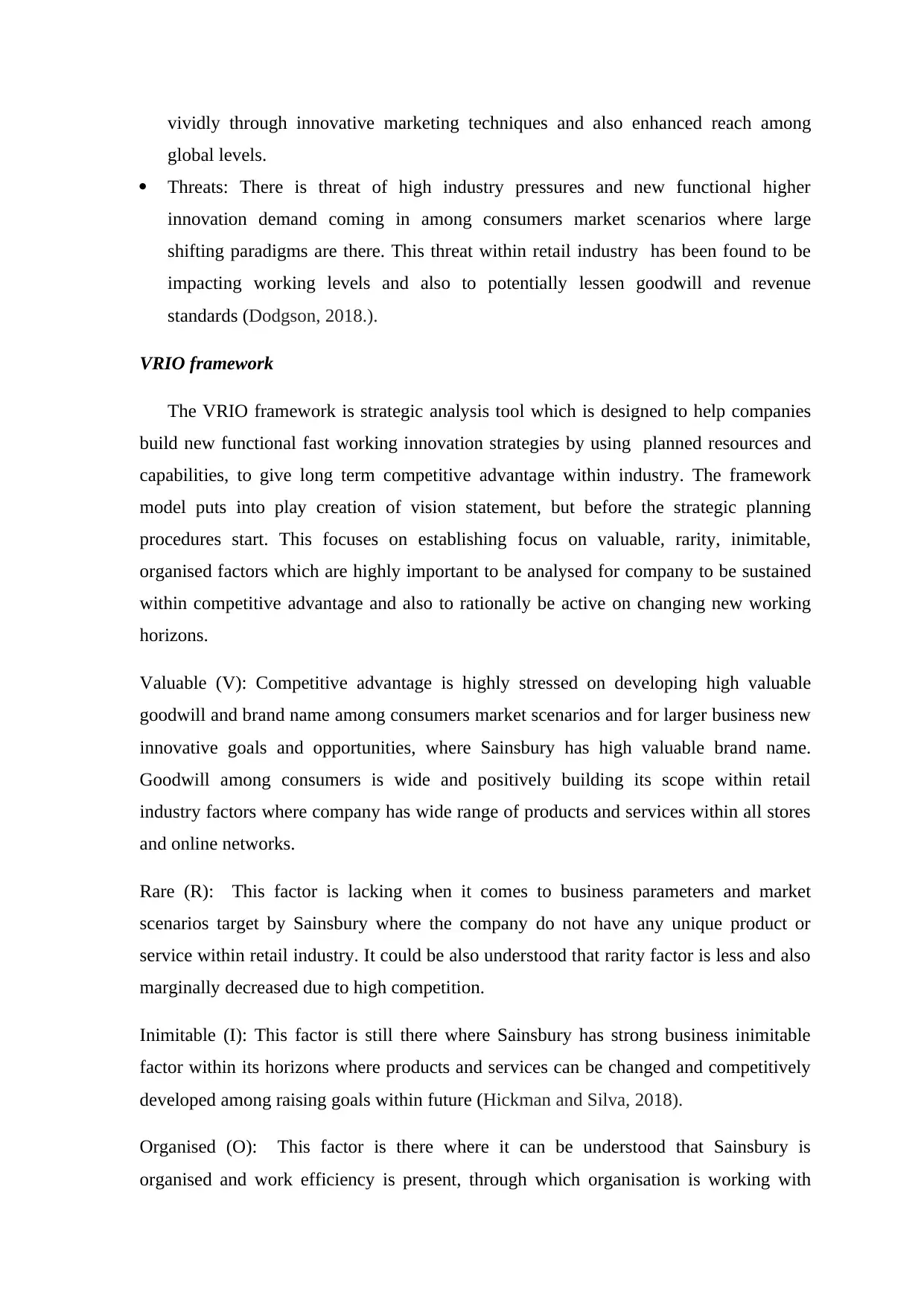
vividly through innovative marketing techniques and also enhanced reach among
global levels.
Threats: There is threat of high industry pressures and new functional higher
innovation demand coming in among consumers market scenarios where large
shifting paradigms are there. This threat within retail industry has been found to be
impacting working levels and also to potentially lessen goodwill and revenue
standards (Dodgson, 2018.).
VRIO framework
The VRIO framework is strategic analysis tool which is designed to help companies
build new functional fast working innovation strategies by using planned resources and
capabilities, to give long term competitive advantage within industry. The framework
model puts into play creation of vision statement, but before the strategic planning
procedures start. This focuses on establishing focus on valuable, rarity, inimitable,
organised factors which are highly important to be analysed for company to be sustained
within competitive advantage and also to rationally be active on changing new working
horizons.
Valuable (V): Competitive advantage is highly stressed on developing high valuable
goodwill and brand name among consumers market scenarios and for larger business new
innovative goals and opportunities, where Sainsbury has high valuable brand name.
Goodwill among consumers is wide and positively building its scope within retail
industry factors where company has wide range of products and services within all stores
and online networks.
Rare (R): This factor is lacking when it comes to business parameters and market
scenarios target by Sainsbury where the company do not have any unique product or
service within retail industry. It could be also understood that rarity factor is less and also
marginally decreased due to high competition.
Inimitable (I): This factor is still there where Sainsbury has strong business inimitable
factor within its horizons where products and services can be changed and competitively
developed among raising goals within future (Hickman and Silva, 2018).
Organised (O): This factor is there where it can be understood that Sainsbury is
organised and work efficiency is present, through which organisation is working with
global levels.
Threats: There is threat of high industry pressures and new functional higher
innovation demand coming in among consumers market scenarios where large
shifting paradigms are there. This threat within retail industry has been found to be
impacting working levels and also to potentially lessen goodwill and revenue
standards (Dodgson, 2018.).
VRIO framework
The VRIO framework is strategic analysis tool which is designed to help companies
build new functional fast working innovation strategies by using planned resources and
capabilities, to give long term competitive advantage within industry. The framework
model puts into play creation of vision statement, but before the strategic planning
procedures start. This focuses on establishing focus on valuable, rarity, inimitable,
organised factors which are highly important to be analysed for company to be sustained
within competitive advantage and also to rationally be active on changing new working
horizons.
Valuable (V): Competitive advantage is highly stressed on developing high valuable
goodwill and brand name among consumers market scenarios and for larger business new
innovative goals and opportunities, where Sainsbury has high valuable brand name.
Goodwill among consumers is wide and positively building its scope within retail
industry factors where company has wide range of products and services within all stores
and online networks.
Rare (R): This factor is lacking when it comes to business parameters and market
scenarios target by Sainsbury where the company do not have any unique product or
service within retail industry. It could be also understood that rarity factor is less and also
marginally decreased due to high competition.
Inimitable (I): This factor is still there where Sainsbury has strong business inimitable
factor within its horizons where products and services can be changed and competitively
developed among raising goals within future (Hickman and Silva, 2018).
Organised (O): This factor is there where it can be understood that Sainsbury is
organised and work efficiency is present, through which organisation is working with
⊘ This is a preview!⊘
Do you want full access?
Subscribe today to unlock all pages.

Trusted by 1+ million students worldwide
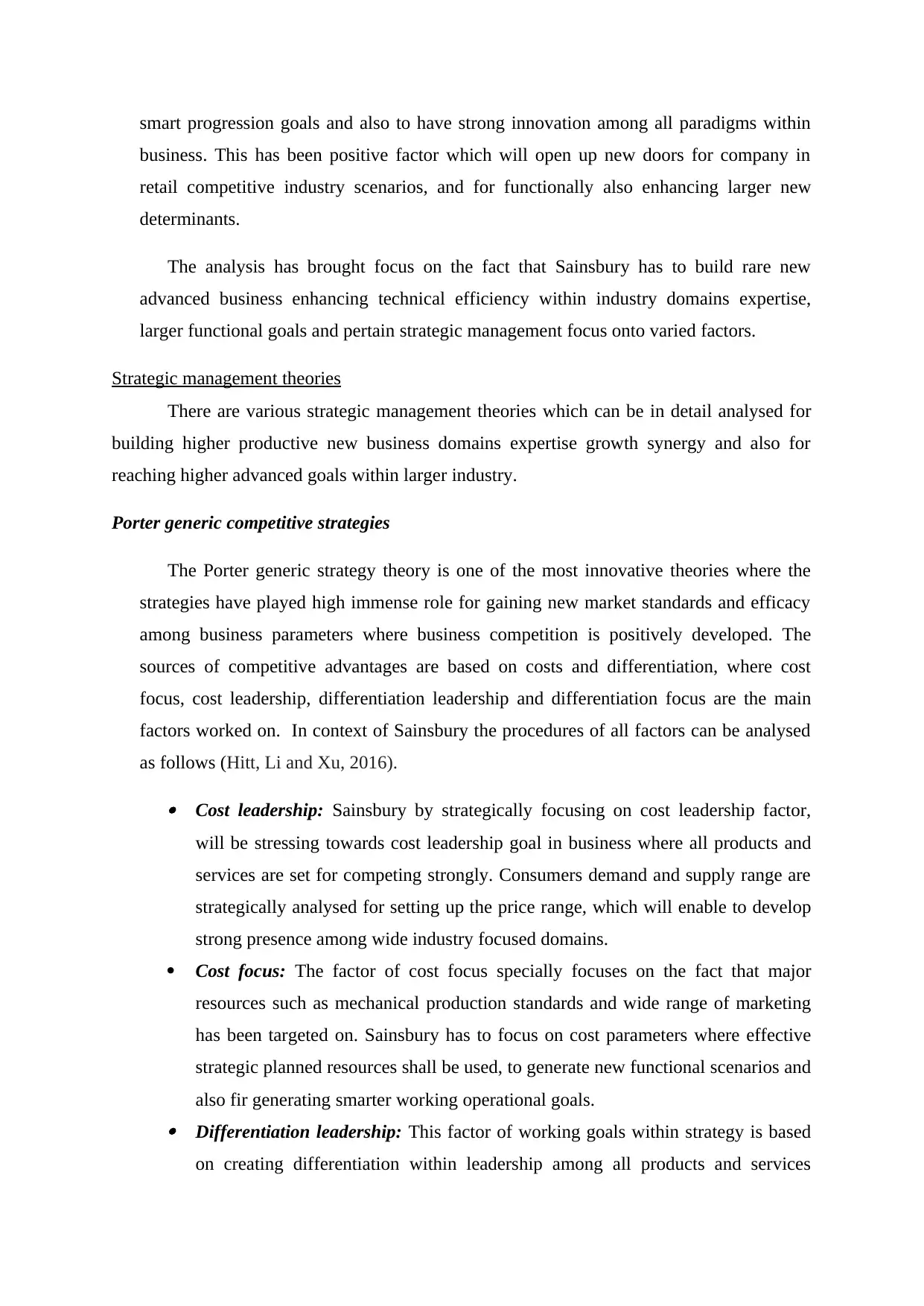
smart progression goals and also to have strong innovation among all paradigms within
business. This has been positive factor which will open up new doors for company in
retail competitive industry scenarios, and for functionally also enhancing larger new
determinants.
The analysis has brought focus on the fact that Sainsbury has to build rare new
advanced business enhancing technical efficiency within industry domains expertise,
larger functional goals and pertain strategic management focus onto varied factors.
Strategic management theories
There are various strategic management theories which can be in detail analysed for
building higher productive new business domains expertise growth synergy and also for
reaching higher advanced goals within larger industry.
Porter generic competitive strategies
The Porter generic strategy theory is one of the most innovative theories where the
strategies have played high immense role for gaining new market standards and efficacy
among business parameters where business competition is positively developed. The
sources of competitive advantages are based on costs and differentiation, where cost
focus, cost leadership, differentiation leadership and differentiation focus are the main
factors worked on. In context of Sainsbury the procedures of all factors can be analysed
as follows (Hitt, Li and Xu, 2016). Cost leadership: Sainsbury by strategically focusing on cost leadership factor,
will be stressing towards cost leadership goal in business where all products and
services are set for competing strongly. Consumers demand and supply range are
strategically analysed for setting up the price range, which will enable to develop
strong presence among wide industry focused domains.
Cost focus: The factor of cost focus specially focuses on the fact that major
resources such as mechanical production standards and wide range of marketing
has been targeted on. Sainsbury has to focus on cost parameters where effective
strategic planned resources shall be used, to generate new functional scenarios and
also fir generating smarter working operational goals.
Differentiation leadership: This factor of working goals within strategy is based
on creating differentiation within leadership among all products and services
business. This has been positive factor which will open up new doors for company in
retail competitive industry scenarios, and for functionally also enhancing larger new
determinants.
The analysis has brought focus on the fact that Sainsbury has to build rare new
advanced business enhancing technical efficiency within industry domains expertise,
larger functional goals and pertain strategic management focus onto varied factors.
Strategic management theories
There are various strategic management theories which can be in detail analysed for
building higher productive new business domains expertise growth synergy and also for
reaching higher advanced goals within larger industry.
Porter generic competitive strategies
The Porter generic strategy theory is one of the most innovative theories where the
strategies have played high immense role for gaining new market standards and efficacy
among business parameters where business competition is positively developed. The
sources of competitive advantages are based on costs and differentiation, where cost
focus, cost leadership, differentiation leadership and differentiation focus are the main
factors worked on. In context of Sainsbury the procedures of all factors can be analysed
as follows (Hitt, Li and Xu, 2016). Cost leadership: Sainsbury by strategically focusing on cost leadership factor,
will be stressing towards cost leadership goal in business where all products and
services are set for competing strongly. Consumers demand and supply range are
strategically analysed for setting up the price range, which will enable to develop
strong presence among wide industry focused domains.
Cost focus: The factor of cost focus specially focuses on the fact that major
resources such as mechanical production standards and wide range of marketing
has been targeted on. Sainsbury has to focus on cost parameters where effective
strategic planned resources shall be used, to generate new functional scenarios and
also fir generating smarter working operational goals.
Differentiation leadership: This factor of working goals within strategy is based
on creating differentiation within leadership among all products and services
Paraphrase This Document
Need a fresh take? Get an instant paraphrase of this document with our AI Paraphraser
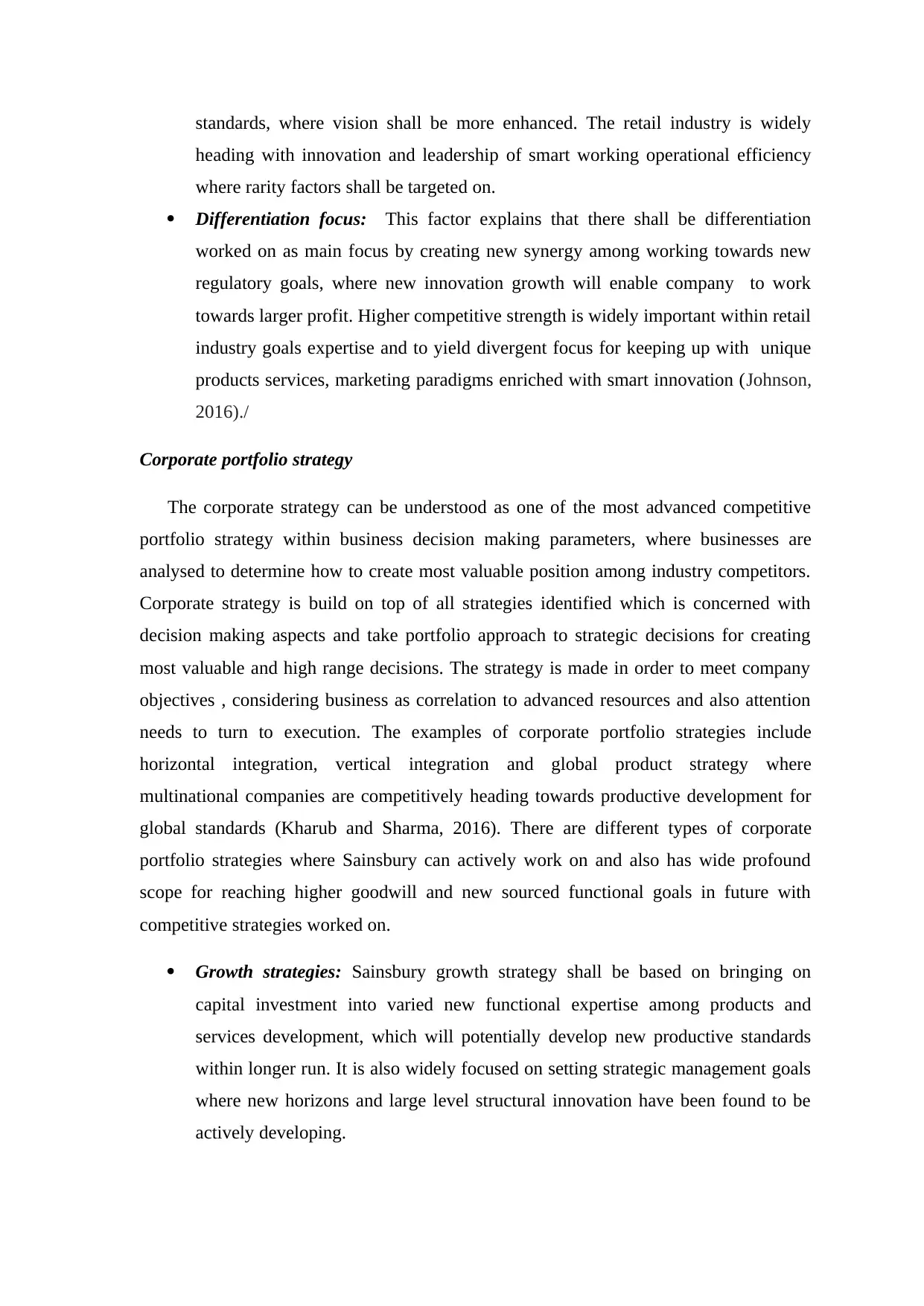
standards, where vision shall be more enhanced. The retail industry is widely
heading with innovation and leadership of smart working operational efficiency
where rarity factors shall be targeted on.
Differentiation focus: This factor explains that there shall be differentiation
worked on as main focus by creating new synergy among working towards new
regulatory goals, where new innovation growth will enable company to work
towards larger profit. Higher competitive strength is widely important within retail
industry goals expertise and to yield divergent focus for keeping up with unique
products services, marketing paradigms enriched with smart innovation (Johnson,
2016)./
Corporate portfolio strategy
The corporate strategy can be understood as one of the most advanced competitive
portfolio strategy within business decision making parameters, where businesses are
analysed to determine how to create most valuable position among industry competitors.
Corporate strategy is build on top of all strategies identified which is concerned with
decision making aspects and take portfolio approach to strategic decisions for creating
most valuable and high range decisions. The strategy is made in order to meet company
objectives , considering business as correlation to advanced resources and also attention
needs to turn to execution. The examples of corporate portfolio strategies include
horizontal integration, vertical integration and global product strategy where
multinational companies are competitively heading towards productive development for
global standards (Kharub and Sharma, 2016). There are different types of corporate
portfolio strategies where Sainsbury can actively work on and also has wide profound
scope for reaching higher goodwill and new sourced functional goals in future with
competitive strategies worked on.
Growth strategies: Sainsbury growth strategy shall be based on bringing on
capital investment into varied new functional expertise among products and
services development, which will potentially develop new productive standards
within longer run. It is also widely focused on setting strategic management goals
where new horizons and large level structural innovation have been found to be
actively developing.
heading with innovation and leadership of smart working operational efficiency
where rarity factors shall be targeted on.
Differentiation focus: This factor explains that there shall be differentiation
worked on as main focus by creating new synergy among working towards new
regulatory goals, where new innovation growth will enable company to work
towards larger profit. Higher competitive strength is widely important within retail
industry goals expertise and to yield divergent focus for keeping up with unique
products services, marketing paradigms enriched with smart innovation (Johnson,
2016)./
Corporate portfolio strategy
The corporate strategy can be understood as one of the most advanced competitive
portfolio strategy within business decision making parameters, where businesses are
analysed to determine how to create most valuable position among industry competitors.
Corporate strategy is build on top of all strategies identified which is concerned with
decision making aspects and take portfolio approach to strategic decisions for creating
most valuable and high range decisions. The strategy is made in order to meet company
objectives , considering business as correlation to advanced resources and also attention
needs to turn to execution. The examples of corporate portfolio strategies include
horizontal integration, vertical integration and global product strategy where
multinational companies are competitively heading towards productive development for
global standards (Kharub and Sharma, 2016). There are different types of corporate
portfolio strategies where Sainsbury can actively work on and also has wide profound
scope for reaching higher goodwill and new sourced functional goals in future with
competitive strategies worked on.
Growth strategies: Sainsbury growth strategy shall be based on bringing on
capital investment into varied new functional expertise among products and
services development, which will potentially develop new productive standards
within longer run. It is also widely focused on setting strategic management goals
where new horizons and large level structural innovation have been found to be
actively developing.
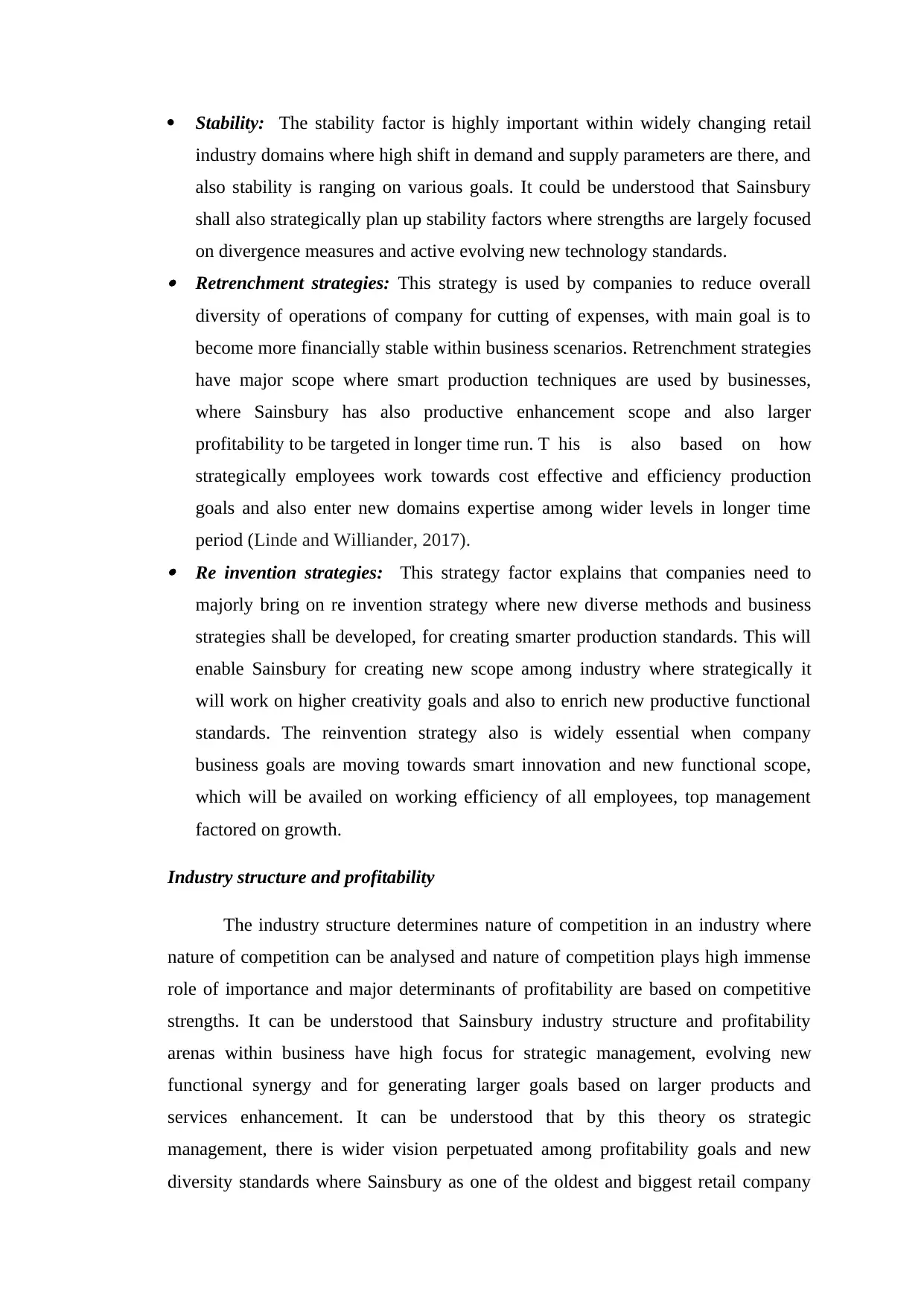
Stability: The stability factor is highly important within widely changing retail
industry domains where high shift in demand and supply parameters are there, and
also stability is ranging on various goals. It could be understood that Sainsbury
shall also strategically plan up stability factors where strengths are largely focused
on divergence measures and active evolving new technology standards.
Retrenchment strategies: This strategy is used by companies to reduce overall
diversity of operations of company for cutting of expenses, with main goal is to
become more financially stable within business scenarios. Retrenchment strategies
have major scope where smart production techniques are used by businesses,
where Sainsbury has also productive enhancement scope and also larger
profitability to be targeted in longer time run. T his is also based on how
strategically employees work towards cost effective and efficiency production
goals and also enter new domains expertise among wider levels in longer time
period (Linde and Williander, 2017).
Re invention strategies: This strategy factor explains that companies need to
majorly bring on re invention strategy where new diverse methods and business
strategies shall be developed, for creating smarter production standards. This will
enable Sainsbury for creating new scope among industry where strategically it
will work on higher creativity goals and also to enrich new productive functional
standards. The reinvention strategy also is widely essential when company
business goals are moving towards smart innovation and new functional scope,
which will be availed on working efficiency of all employees, top management
factored on growth.
Industry structure and profitability
The industry structure determines nature of competition in an industry where
nature of competition can be analysed and nature of competition plays high immense
role of importance and major determinants of profitability are based on competitive
strengths. It can be understood that Sainsbury industry structure and profitability
arenas within business have high focus for strategic management, evolving new
functional synergy and for generating larger goals based on larger products and
services enhancement. It can be understood that by this theory os strategic
management, there is wider vision perpetuated among profitability goals and new
diversity standards where Sainsbury as one of the oldest and biggest retail company
industry domains where high shift in demand and supply parameters are there, and
also stability is ranging on various goals. It could be understood that Sainsbury
shall also strategically plan up stability factors where strengths are largely focused
on divergence measures and active evolving new technology standards.
Retrenchment strategies: This strategy is used by companies to reduce overall
diversity of operations of company for cutting of expenses, with main goal is to
become more financially stable within business scenarios. Retrenchment strategies
have major scope where smart production techniques are used by businesses,
where Sainsbury has also productive enhancement scope and also larger
profitability to be targeted in longer time run. T his is also based on how
strategically employees work towards cost effective and efficiency production
goals and also enter new domains expertise among wider levels in longer time
period (Linde and Williander, 2017).
Re invention strategies: This strategy factor explains that companies need to
majorly bring on re invention strategy where new diverse methods and business
strategies shall be developed, for creating smarter production standards. This will
enable Sainsbury for creating new scope among industry where strategically it
will work on higher creativity goals and also to enrich new productive functional
standards. The reinvention strategy also is widely essential when company
business goals are moving towards smart innovation and new functional scope,
which will be availed on working efficiency of all employees, top management
factored on growth.
Industry structure and profitability
The industry structure determines nature of competition in an industry where
nature of competition can be analysed and nature of competition plays high immense
role of importance and major determinants of profitability are based on competitive
strengths. It can be understood that Sainsbury industry structure and profitability
arenas within business have high focus for strategic management, evolving new
functional synergy and for generating larger goals based on larger products and
services enhancement. It can be understood that by this theory os strategic
management, there is wider vision perpetuated among profitability goals and new
diversity standards where Sainsbury as one of the oldest and biggest retail company
⊘ This is a preview!⊘
Do you want full access?
Subscribe today to unlock all pages.

Trusted by 1+ million students worldwide
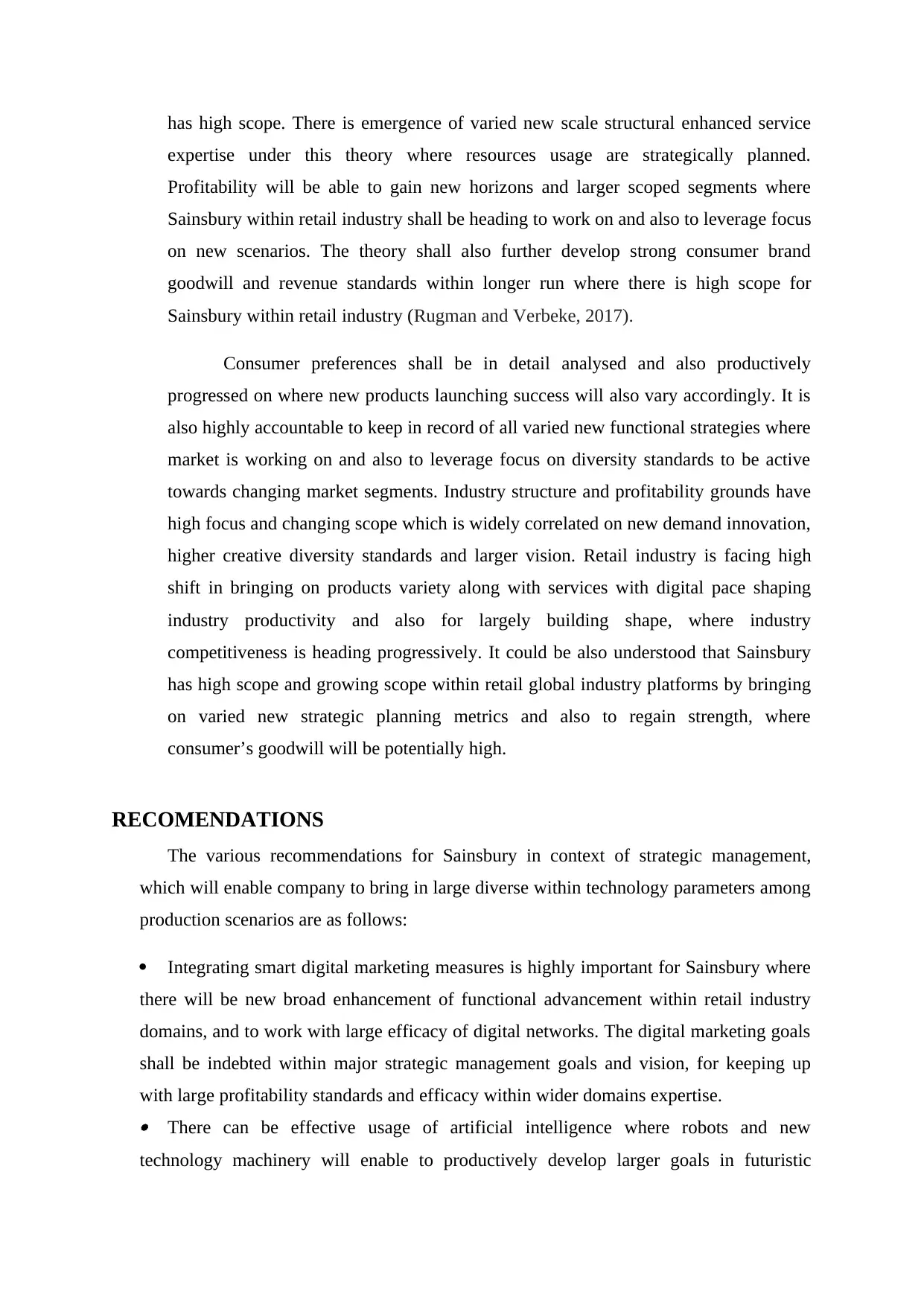
has high scope. There is emergence of varied new scale structural enhanced service
expertise under this theory where resources usage are strategically planned.
Profitability will be able to gain new horizons and larger scoped segments where
Sainsbury within retail industry shall be heading to work on and also to leverage focus
on new scenarios. The theory shall also further develop strong consumer brand
goodwill and revenue standards within longer run where there is high scope for
Sainsbury within retail industry (Rugman and Verbeke, 2017).
Consumer preferences shall be in detail analysed and also productively
progressed on where new products launching success will also vary accordingly. It is
also highly accountable to keep in record of all varied new functional strategies where
market is working on and also to leverage focus on diversity standards to be active
towards changing market segments. Industry structure and profitability grounds have
high focus and changing scope which is widely correlated on new demand innovation,
higher creative diversity standards and larger vision. Retail industry is facing high
shift in bringing on products variety along with services with digital pace shaping
industry productivity and also for largely building shape, where industry
competitiveness is heading progressively. It could be also understood that Sainsbury
has high scope and growing scope within retail global industry platforms by bringing
on varied new strategic planning metrics and also to regain strength, where
consumer’s goodwill will be potentially high.
RECOMENDATIONS
The various recommendations for Sainsbury in context of strategic management,
which will enable company to bring in large diverse within technology parameters among
production scenarios are as follows:
Integrating smart digital marketing measures is highly important for Sainsbury where
there will be new broad enhancement of functional advancement within retail industry
domains, and to work with large efficacy of digital networks. The digital marketing goals
shall be indebted within major strategic management goals and vision, for keeping up
with large profitability standards and efficacy within wider domains expertise. There can be effective usage of artificial intelligence where robots and new
technology machinery will enable to productively develop larger goals in futuristic
expertise under this theory where resources usage are strategically planned.
Profitability will be able to gain new horizons and larger scoped segments where
Sainsbury within retail industry shall be heading to work on and also to leverage focus
on new scenarios. The theory shall also further develop strong consumer brand
goodwill and revenue standards within longer run where there is high scope for
Sainsbury within retail industry (Rugman and Verbeke, 2017).
Consumer preferences shall be in detail analysed and also productively
progressed on where new products launching success will also vary accordingly. It is
also highly accountable to keep in record of all varied new functional strategies where
market is working on and also to leverage focus on diversity standards to be active
towards changing market segments. Industry structure and profitability grounds have
high focus and changing scope which is widely correlated on new demand innovation,
higher creative diversity standards and larger vision. Retail industry is facing high
shift in bringing on products variety along with services with digital pace shaping
industry productivity and also for largely building shape, where industry
competitiveness is heading progressively. It could be also understood that Sainsbury
has high scope and growing scope within retail global industry platforms by bringing
on varied new strategic planning metrics and also to regain strength, where
consumer’s goodwill will be potentially high.
RECOMENDATIONS
The various recommendations for Sainsbury in context of strategic management,
which will enable company to bring in large diverse within technology parameters among
production scenarios are as follows:
Integrating smart digital marketing measures is highly important for Sainsbury where
there will be new broad enhancement of functional advancement within retail industry
domains, and to work with large efficacy of digital networks. The digital marketing goals
shall be indebted within major strategic management goals and vision, for keeping up
with large profitability standards and efficacy within wider domains expertise. There can be effective usage of artificial intelligence where robots and new
technology machinery will enable to productively develop larger goals in futuristic
Paraphrase This Document
Need a fresh take? Get an instant paraphrase of this document with our AI Paraphraser
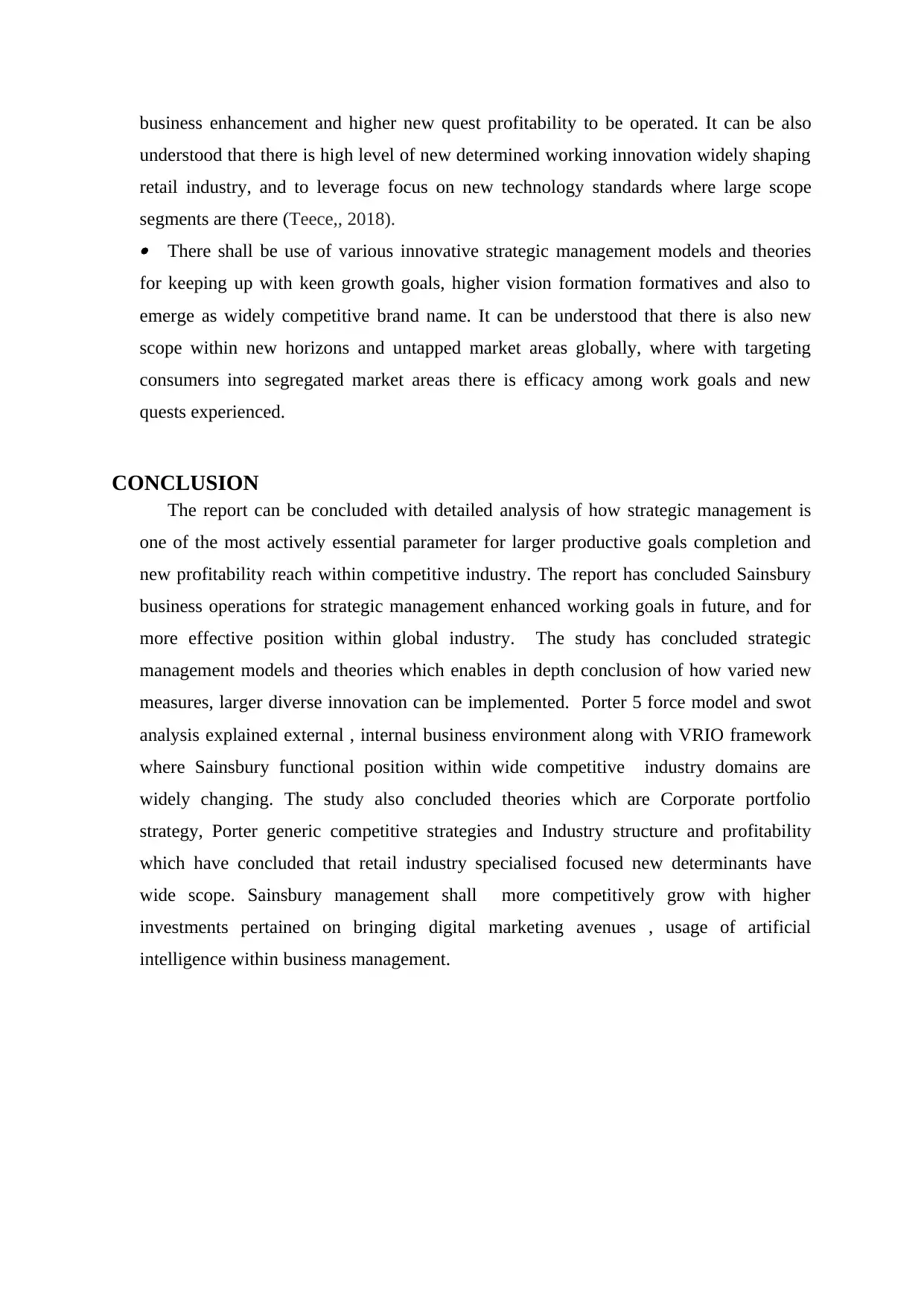
business enhancement and higher new quest profitability to be operated. It can be also
understood that there is high level of new determined working innovation widely shaping
retail industry, and to leverage focus on new technology standards where large scope
segments are there (Teece,, 2018). There shall be use of various innovative strategic management models and theories
for keeping up with keen growth goals, higher vision formation formatives and also to
emerge as widely competitive brand name. It can be understood that there is also new
scope within new horizons and untapped market areas globally, where with targeting
consumers into segregated market areas there is efficacy among work goals and new
quests experienced.
CONCLUSION
The report can be concluded with detailed analysis of how strategic management is
one of the most actively essential parameter for larger productive goals completion and
new profitability reach within competitive industry. The report has concluded Sainsbury
business operations for strategic management enhanced working goals in future, and for
more effective position within global industry. The study has concluded strategic
management models and theories which enables in depth conclusion of how varied new
measures, larger diverse innovation can be implemented. Porter 5 force model and swot
analysis explained external , internal business environment along with VRIO framework
where Sainsbury functional position within wide competitive industry domains are
widely changing. The study also concluded theories which are Corporate portfolio
strategy, Porter generic competitive strategies and Industry structure and profitability
which have concluded that retail industry specialised focused new determinants have
wide scope. Sainsbury management shall more competitively grow with higher
investments pertained on bringing digital marketing avenues , usage of artificial
intelligence within business management.
understood that there is high level of new determined working innovation widely shaping
retail industry, and to leverage focus on new technology standards where large scope
segments are there (Teece,, 2018). There shall be use of various innovative strategic management models and theories
for keeping up with keen growth goals, higher vision formation formatives and also to
emerge as widely competitive brand name. It can be understood that there is also new
scope within new horizons and untapped market areas globally, where with targeting
consumers into segregated market areas there is efficacy among work goals and new
quests experienced.
CONCLUSION
The report can be concluded with detailed analysis of how strategic management is
one of the most actively essential parameter for larger productive goals completion and
new profitability reach within competitive industry. The report has concluded Sainsbury
business operations for strategic management enhanced working goals in future, and for
more effective position within global industry. The study has concluded strategic
management models and theories which enables in depth conclusion of how varied new
measures, larger diverse innovation can be implemented. Porter 5 force model and swot
analysis explained external , internal business environment along with VRIO framework
where Sainsbury functional position within wide competitive industry domains are
widely changing. The study also concluded theories which are Corporate portfolio
strategy, Porter generic competitive strategies and Industry structure and profitability
which have concluded that retail industry specialised focused new determinants have
wide scope. Sainsbury management shall more competitively grow with higher
investments pertained on bringing digital marketing avenues , usage of artificial
intelligence within business management.
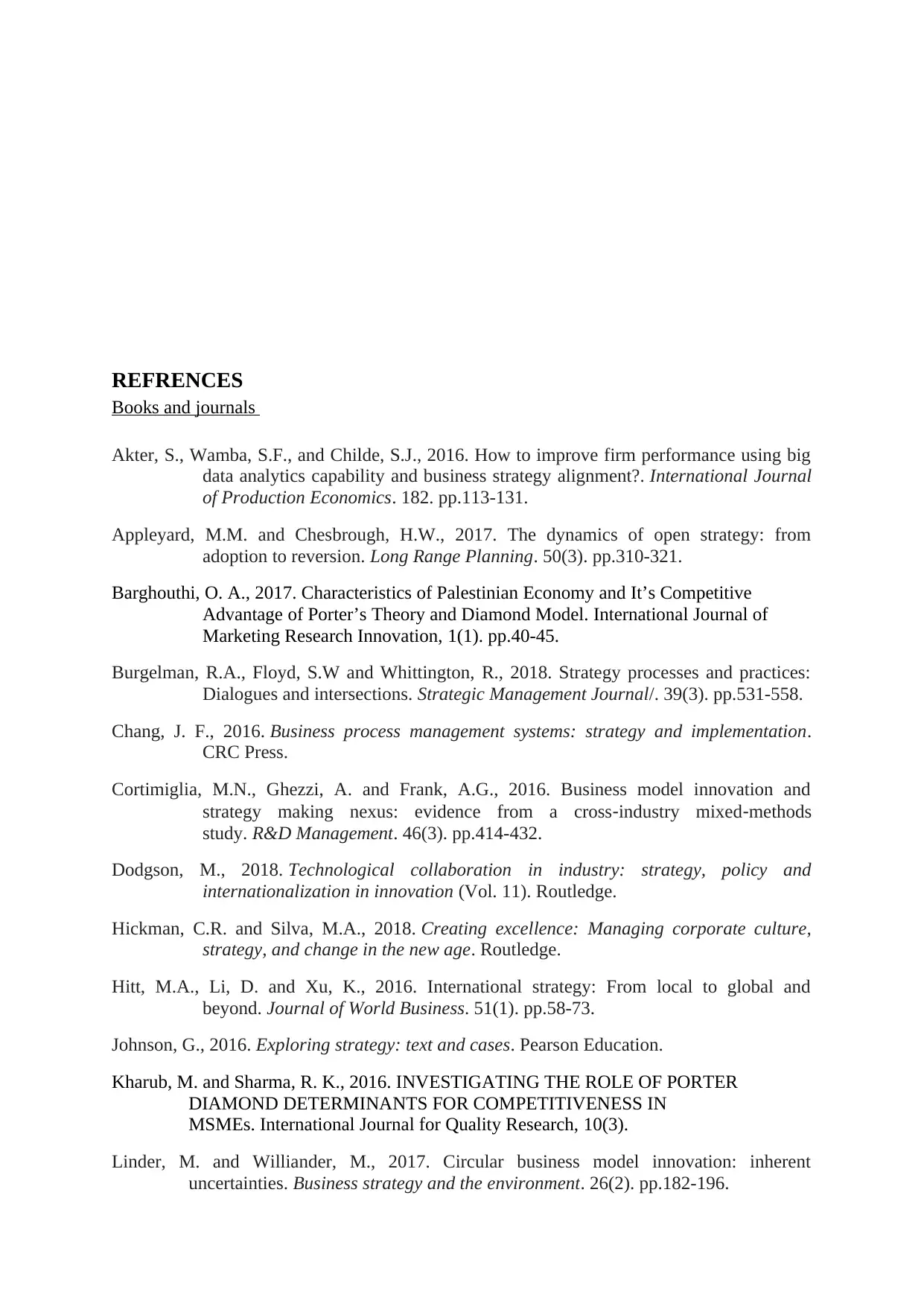
REFRENCES
Books and journals
Akter, S., Wamba, S.F., and Childe, S.J., 2016. How to improve firm performance using big
data analytics capability and business strategy alignment?. International Journal
of Production Economics. 182. pp.113-131.
Appleyard, M.M. and Chesbrough, H.W., 2017. The dynamics of open strategy: from
adoption to reversion. Long Range Planning. 50(3). pp.310-321.
Barghouthi, O. A., 2017. Characteristics of Palestinian Economy and It’s Competitive
Advantage of Porter’s Theory and Diamond Model. International Journal of
Marketing Research Innovation, 1(1). pp.40-45.
Burgelman, R.A., Floyd, S.W and Whittington, R., 2018. Strategy processes and practices:
Dialogues and intersections. Strategic Management Journal/. 39(3). pp.531-558.
Chang, J. F., 2016. Business process management systems: strategy and implementation.
CRC Press.
Cortimiglia, M.N., Ghezzi, A. and Frank, A.G., 2016. Business model innovation and
strategy making nexus: evidence from a cross‐industry mixed‐methods
study. R&D Management. 46(3). pp.414-432.
Dodgson, M., 2018. Technological collaboration in industry: strategy, policy and
internationalization in innovation (Vol. 11). Routledge.
Hickman, C.R. and Silva, M.A., 2018. Creating excellence: Managing corporate culture,
strategy, and change in the new age. Routledge.
Hitt, M.A., Li, D. and Xu, K., 2016. International strategy: From local to global and
beyond. Journal of World Business. 51(1). pp.58-73.
Johnson, G., 2016. Exploring strategy: text and cases. Pearson Education.
Kharub, M. and Sharma, R. K., 2016. INVESTIGATING THE ROLE OF PORTER
DIAMOND DETERMINANTS FOR COMPETITIVENESS IN
MSMEs. International Journal for Quality Research, 10(3).
Linder, M. and Williander, M., 2017. Circular business model innovation: inherent
uncertainties. Business strategy and the environment. 26(2). pp.182-196.
Books and journals
Akter, S., Wamba, S.F., and Childe, S.J., 2016. How to improve firm performance using big
data analytics capability and business strategy alignment?. International Journal
of Production Economics. 182. pp.113-131.
Appleyard, M.M. and Chesbrough, H.W., 2017. The dynamics of open strategy: from
adoption to reversion. Long Range Planning. 50(3). pp.310-321.
Barghouthi, O. A., 2017. Characteristics of Palestinian Economy and It’s Competitive
Advantage of Porter’s Theory and Diamond Model. International Journal of
Marketing Research Innovation, 1(1). pp.40-45.
Burgelman, R.A., Floyd, S.W and Whittington, R., 2018. Strategy processes and practices:
Dialogues and intersections. Strategic Management Journal/. 39(3). pp.531-558.
Chang, J. F., 2016. Business process management systems: strategy and implementation.
CRC Press.
Cortimiglia, M.N., Ghezzi, A. and Frank, A.G., 2016. Business model innovation and
strategy making nexus: evidence from a cross‐industry mixed‐methods
study. R&D Management. 46(3). pp.414-432.
Dodgson, M., 2018. Technological collaboration in industry: strategy, policy and
internationalization in innovation (Vol. 11). Routledge.
Hickman, C.R. and Silva, M.A., 2018. Creating excellence: Managing corporate culture,
strategy, and change in the new age. Routledge.
Hitt, M.A., Li, D. and Xu, K., 2016. International strategy: From local to global and
beyond. Journal of World Business. 51(1). pp.58-73.
Johnson, G., 2016. Exploring strategy: text and cases. Pearson Education.
Kharub, M. and Sharma, R. K., 2016. INVESTIGATING THE ROLE OF PORTER
DIAMOND DETERMINANTS FOR COMPETITIVENESS IN
MSMEs. International Journal for Quality Research, 10(3).
Linder, M. and Williander, M., 2017. Circular business model innovation: inherent
uncertainties. Business strategy and the environment. 26(2). pp.182-196.
⊘ This is a preview!⊘
Do you want full access?
Subscribe today to unlock all pages.

Trusted by 1+ million students worldwide
1 out of 13
Related Documents
Your All-in-One AI-Powered Toolkit for Academic Success.
+13062052269
info@desklib.com
Available 24*7 on WhatsApp / Email
![[object Object]](/_next/static/media/star-bottom.7253800d.svg)
Unlock your academic potential
Copyright © 2020–2025 A2Z Services. All Rights Reserved. Developed and managed by ZUCOL.




